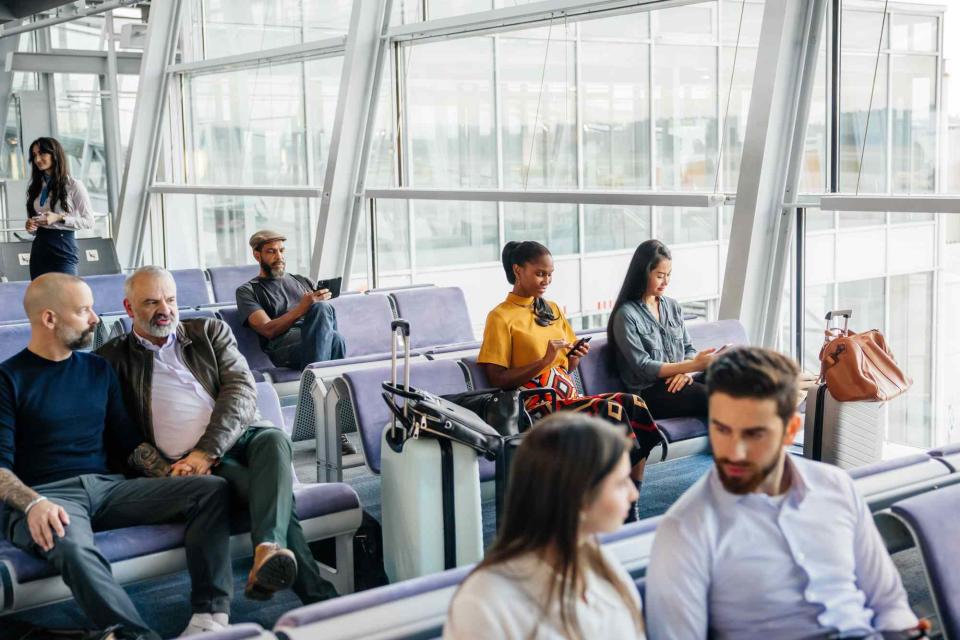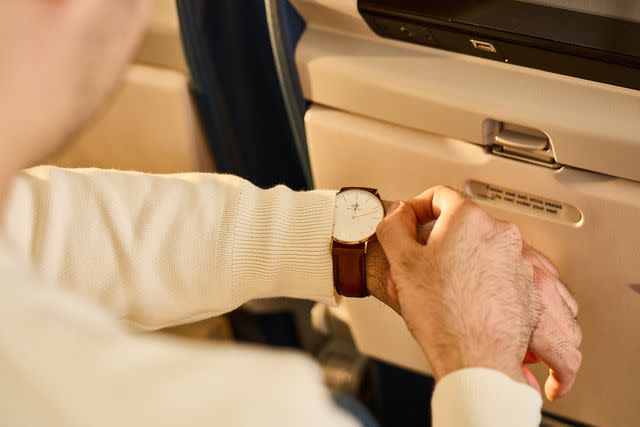Do Airlines Really Have Dress Codes? What to Know
Here's what you should know about airline rules for passenger attire — and what happens if you break them.

Hinterhaus Productions/Getty Images
Passengers waiting in an airport terminal.Once upon a time, people dressed up to go to the airport. It was a high-end activity, and the clothes you saw reflected that. Today, comfort reigns supreme. As a full-time traveler, I’ve been to airports worldwide, and it’s largely the same image everywhere. While some business travelers wear professional attire, everyone else is in sweatpants, pajamas, athleisure, or anything else comfortable to make their journey.
You’ve likely heard the horror stories of people being denied boarding for inappropriate attire. However, what exactly is considered inappropriate, and who enforces this rule? Here’s what you need to know about airline dress codes.
Do airlines have dress codes?
Every major U.S. airline has clauses in their contract of carriage (the agreement you enter when you fly with an airline) surrounding attire. Usually, they include provisions that state you must wear appropriate clothing and not be barefoot or emit a strong odor unless it is due to a medical condition. The dress code is typically left very vague, so it’s mainly up to the discretion of the airline staff to enforce. This has resulted in several stories of passengers being denied boarding for clothing that others may deem suitable for flying.
Only one major airline in the U.S., Hawaiian Airlines, has specific descriptions of what you can and cannot wear in their contract of carriage. Most other airlines have very similar policies that outline the potential consequences for wearing clothing that is deemed to violate the code, so we've listed the relevant clauses for each below.
Related: 25 Things You Should Do Before Boarding a Plane, According to a Frequent Flier
Airline Dress Code Policies
Southwest Airlines
A Southwest spokesperson told Travel + Leisure, “Southwest doesn’t have an official dress code, though there are some provisions mentioned in our contract of carriage.”
The contract of carriage states that the airline may refuse to transport or remove an unruly or disruptive passenger from an aircraft at any point. According to Southwest, “disruptive or unruly conduct includes, but is not limited to, the following: engaging in lewd, obscene, or patently offensive behavior, including wearing clothes that are lewd, obscene, or patently offensive.
American Airlines
American Airlines passengers must “dress appropriately; bare feet or offensive clothing aren’t allowed.” If an airline employee believes you're dressed inappropriately, you may be denied boarding, removed from the terminal, or face legal consequences, according to AA's conditions of carriage.
Delta Air Lines
“Delta may refuse to transport or may remove passengers from its aircraft in situations when the passenger is barefoot" and "when the passenger’s conduct, attire, hygiene or odor creates an unreasonable risk of offense or annoyance to other passengers,” per the airline's contract of carriage.
United Airlines
Similarly, United's contract of carriage reads, “UA shall have the right to refuse transport on a permanent or temporary basis or shall have the right to remove from the aircraft at any point, any passengers who are barefoot, not properly clothed, or whose clothing is lewd, obscene or offensive.”
Spirit Airlines
Per Spirit's contract of carriage, “A guest shall not be permitted to board the aircraft or may be required to leave an aircraft if that guest is barefoot or inadequately clothed, or whose clothing is lewd, obscene, or offensive in nature.”
JetBlue
In its contract of carriage, JetBlue states that "persons whose conduct is or has been known to be disorderly, abusive, offensive, threatening, intimidating, violent, or whose clothing is lewd, obscene, or patently offensive" and "persons who are barefoot and over five years old" can be refused boarding or removed from a plane if "necessary for the comfort or safety of the passenger(s) or other passengers."
Alaska Airlines
“Alaska may, in its sole discretion, refuse to transport, or may remove from an aircraft at any point, any passenger in any circumstance not prohibited by law," per the Alaska Airlines contract of carriage. That includes "passengers who are barefoot or whose conduct, attire, hygiene, or odor creates an unreasonable risk of offense or annoyance to other passengers.”
Hawaiian Airlines
Hawaiian has a specific dress code policy that outlines items that are and are not allowed — but basically, they just want you to leave your swimsuit in your luggage. Here's what their contract of carriage says:
“Clothing must cover the upper part of the torso. Tank tops, tube tops, and halter tops are allowed.
Clothing must cover the lower part of the torso. Shorts are allowed. However, speedos and bikini bottoms are not allowed.
Footwear is required for safety reasons unless you are unable to do so because of a disability or physical condition that prevents you from wearing footwear.
In all cases, clothing must not be lewd, obscene, or patently offensive to others.”

Margot Cavin/Travel + Leisure
Plane passenger adjusting his watch.Related: What to Wear on a Plane, According to a Travel Writer Who Flies 50 Times a Year
What happens if you break the dress code?
If you break the clothing policies outlined in the contract of carriage, you’ll likely be asked to cover up. If you have a sweatshirt or a change of clothes in your carry-on bag, you can quickly change your outfit to make it more appropriate. If you can’t change, you risk being denied boarding or even removed from the plane. If this turned into a larger event and you were to cause a delay or diversion, it could be much worse.
According to Southwest, you can be held liable for costs and damages incurred as a result of your disruptive or unruly conduct, which can include:
“Compensation for delay to passengers, crew members, and carrier caused by the disruptive or unruly conduct of that passenger."
"The costs incurred by the carrier attributable to any diversion or delay or other interference with the operation of the aircraft due to the disruptive or unruly conduct of that passenger, including landing and parking fees, fuel purchases, and payments for food and lodging made available to passengers as a result of the diversion.”
This is clearly the worst-case scenario, but it’s important to know that you agree to these terms and conditions when you purchase a plane ticket.
Bottom Line
As you can see, most airlines have the same general policy. You’re not allowed to wear anything deemed inappropriate or lewd, you cannot have an odor that creates a risk or annoyance to other passengers (unless caused by a medical condition), and you can’t be barefoot. If you go against the conditions outlined in the airline's contract of carriage, you can be removed from the plane, denied boarding, or asked to cover up.
For more Travel & Leisure news, make sure to sign up for our newsletter!
Read the original article on Travel & Leisure.


